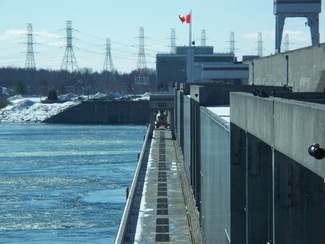Ottawa, ON – Marine shipping executives are calling on government officials to protect the Great Lakes-St. Lawrence Seaway trade corridor by working with stakeholders to develop solutions that do not rely on one ineffective dam to solve high water levels across the Great Lakes. The issue, which has already cost the economy millions of dollars, was a top priority as representatives across Canada’s business sectors met today with federal government officials during Marine Day on the Hill, organized by the Chamber of Marine Commerce.
High water levels have been negatively impacting shoreline residents and businesses, including those that depend on Seaway shipping.
“Going forward, we need to get together to develop a much broader, holistic resiliency plan that can address stakeholder needs and deliver actual, real results. It’s time for politicians to start working with all the affected residents, businesses and shipping stakeholders on smart, effective solutions for high water levels,” said Bruce Burrows, President and CEO of the Chamber of Marine Commerce.
The CMC understands the International Lake Ontario-St. Lawrence River board (ILORB) is currently considering raising outflows at the Moses-Saunders dam to a level that would lead to delaying the opening of navigation through the Montreal-Lake Ontario section of the St. Lawrence Seaway – an unprecedented move. With little ice coverage being experienced this year, typically the shipping season would open around March 20.
“Shutting down or interrupting Canadian, American and international trade on the St. Lawrence Seaway and further damaging the economy and our nation’s global trading reputation should never be an option,” said Mr. Burrows. “Given the current disruption impacting Canada’s national railways, we certainly do not need any delays of transportation of critical supplies and products along this important trade corridor.”
In 2019, marine shipping worked diligently with stakeholders to ensure safe navigation at record outflow levels from Moses-Saunders dam on the St. Lawrence Seaway for five months to help lower Lake Ontario, taking on 26 mitigation measures that caused shipping delays, lost cargo business and millions of dollars of extra operating costs. The marine shipping industry is working with officials across both sides of the border, as well as scientific experts here in Canada to study what improvements can be made that could lead to navigation during increased outflow periods if water causes flooding on Lake Ontario in 2020.
But, the rising water levels have continuously led to calls by shoreline residents to “open the floodgates” at the dam. This move would create fast-moving, unsafe currents that would stop marine shipping and cost the Canadian and American economies up to $250 million in lost business revenues a week – impacting farmers, steel and manufacturing employees, miners and construction workers and the myriad of others whose livelihoods depend on the cargo carried on the waterway.





